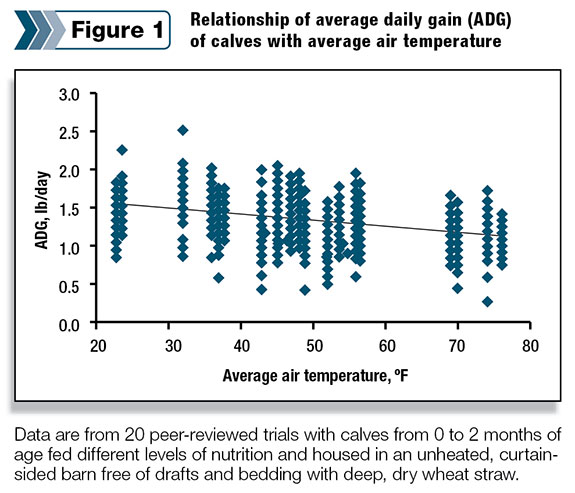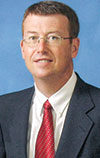A recent USDA survey reported that few custom calf raisers feed calves the large amounts of milk or milk replacer common with intensive feeding programs. Most custom calf raisers are feeding approximately one gallon per calf daily. Many want to know: Why?
There is a lot of press about the value of feeding 1.5 to 2.5 gallons of milk or milk replacer to calves. Some of this press relates to issues with better calf health and immunity, more milk produced by these calves when they eventually calve into the lactating herd and cold stress on the baby calf.
We will summarize what the peer-reviewed research says about these topics and relate it back to what producers really feed their calves.
Conventional feeding programs developed in the 1950s and 1960s were predicated on limited milk or milk replacer, early and aggressive intake of starter, early weaning and low feed and labor costs relative to feeding more milk or milk replacer.
Conventional programs were also based on individually housed calves, which limits calf-to-calf contact and transmission of disease.
Let’s stop here and consider the old phrase “money makes the world go round.” Economics frequently drive decisions. Cheap and limited feed (waste milk) may be a big reason why conventional programs for feeding baby calves have lasted more than 50 years in our industry.
Research with intensive feeding programs
There are dozens of peer-reviewed studies that show as more milk or milk replacer is fed to young calves less than a month old, average daily gain (ADG) increases.
However, when the amount of milk or milk replacer fed is more than approximately 1.5 gallons (or 1.5 lb of solids), early post-weaning ADG has been compromised because of less digestion of starter feed.
The starter was less digested because pre-weaning starter intake was very low, thus the rumen was less-developed post-weaning.
A recent summary of calf feeding programs assembled the data of 10 trials from six different laboratories, comparing conventional with intensive feeding programs and tracking calf performance to an average of 115 days.
Feeding programs tested in the trials ranged from conventionally fed calves receiving approximately one gallon of milk replacer daily (averaging 20 percent protein, 19 percent fat), to moderately intensive programs (averaging 25 percent protein, 16 percent fat) delivering approximately 1.5 gallons of milk replacer daily, to intensive programs delivering approximately two gallons of milk replacer daily (averaging 28 percent protein, 17 percent fat).
Calves fed the moderately intensive program gained 29 percent better, and calves fed the intensive program gained 41 percent better than calves fed the conventional program pre-weaning.
However, post-weaning ADG was least for calves fed the intensive program.
Overall from zero to 115 days, calves fed moderately intensive milk replacer gained 12 percent more weight than calves fed the conventional program, while calves fed intensive milk replacer programs gained 6 percent more weight than calves fed the conventional program.
Several research trials indicate that there are optimal protein and fat (or energy) ratios for milk replacers, and the optimal ratios are approximately 25 percent protein with 17 percent fat with moderate and intensive programs. Feeding low-protein (i.e. 20 percent) milk replacers at high rates leads to fattening rather than muscle and frame growth.
Costs of feeds differ with time, but when costs were estimated in these trials, feed costs of calves fed the moderately intensive and intensive milk replacer programs were more than $40 to $60 more per calf compared to the conventional program.
Similarly, feed cost per unit bodyweight gain was estimated to increase as more milk replacer was fed. Milk replacer is expensive, especially when compared to waste milk. Again, if economics drive a program with producers, they favor conventional programs.
Intrinsic benefits to feeding more milk
Improved immunity and health are often cited as being reasons to feed more milk.
However, five studies from four laboratories have evaluated immunity, and dozens of studies have evaluated health, and none suggest that health in the first two months is improved with intensive feeding compared to conventional programs.
In three trials, there was more respiratory or digestive sickness with intensive than moderately intensive or conventional programs, signaling a need for excellent colostrum, hygiene and caretaking when intensive programs are fed.
Several peer-reviewed studies have examined feeding more milk on future milk production, but only two of seven have reported statistical increases in milk production. Those two studies compared an inferior milk replacer (using alternative ingredients compared to milk) to feeding more nutrients from whole milk.
Recently, a positive relationship to increasing pre-weaning calf ADG to increasing milk production in first lactation has been reported – but not because of level of milk or milk replacer fed.
When taking estimates from this study for pre-weaning ADG and estimating a future profit from feeding more milk replacer, the value of estimated future milk potential (yes, there are uncertainties here) from both moderately intensive and intensive milk replacer programs will more than pay for the extra costs.
Intensive programs do require more quantity and quality of labor. Feeding time is increased. Sometimes these programs increase the days calves are housed in hutches or a nursery, which adds to labor, bedding (if bedding is used) and capital requirements.
Additionally, calves receive increasing amounts – followed by decreasing amounts – of milk or milk replacer with age.
With intensive programs, the post-weaning slump in growth can be avoided by reducing the amount of milk or milk replacer fed over a three-week period to allow starter intake to increase and the rumen to develop.
This complexity in feeding requires extra management and operating procedures than a single feeding rate, conventional program.
Moderately intensive programs feeding approximately 1.5 gallons of milk or milk replacer do not have the complexity of multiple feeding rates, nor do they require additional labor.
When feeding intensive programs, one needs to have an excellent heifer-growing program to capture and retain the early growth to calving. This means feeding adequate concentrate until approximately 4 months old and quality forages with properly balanced diets thereafter.
Baby calves are very prone to thermal (cold or heat) stress. Numerous popular press articles discuss the need for more milk or milk replacer to be fed with cold stress. In fact, there are at least six peer-reviewed studies that report no improvements in ADG of calves fed extra fat during cold and heat stress situations.
In many situations where housing is less than optimal, extra liquid nutrition over conventional programs may be needed to overcome thermal stress of the calf less than 3 weeks old.
Less-than-optimal housing could result in calves exposed to cold drafts or housed directly on slats or concrete or in housing without bedding that properly insulates the calf (i.e. wet bedding, sand, shavings).
Conventional programs may barely cover or not cover the maintenance energy requirements of calves during thermal stress. In many thermal stress situations, the moderate programs feeding 1.5 gallons of milk or milk replacer provides adequate nutrients for growth even with the thermal stress.

Calves are somewhat tolerant to cold or they would not survive in our conventional housing.
This is evident in a 20-trial summary of studies evaluating many different feeding programs for calves in all seasons of the year with calves protected from drafts and bedded with straw ( Figure 1 ).
Here ADG increased as average trial temperature declined down to the lowest average trial temperature of 22ºF.
Some geographic regions have two-month average temperatures below 22ºF, and undoubtedly there is a low temperature where the ADG line in Figure 1 would turn down.
This analysis and other published trials point out the negative impact that heat stress has on calves and suggests that more milk or milk replacer should be fed to offset heat stress.
On farms, extreme cold and snow and, conversely, extreme heat waves have been associated with significant death losses. Thermal stress is real, and providing extra nutrition above conventional feeding programs can play a role in ameliorating it.
Summary
Economics is likely why conventional programs feeding a gallon of milk and milk replacer have been around so long. Consider your operation and evaluate your needs.
Decision-making considerations for feeding programs for your operation include housing and bedding used, heat and cold stress extremes you experience over the year, current mortality/morbidity rates and labor quantity and quality.
Feeding calves two or more gallons of milk or milk replacer with intensive programs means the need for more intensive management from birth throughout the heifer-rearing program to be able to realistically retain early growth through the entire heifer phase.
Feeding calves approximately 1.5 gallons of milk or milk replacer in a moderate program is simple to feed, moderate in cost and is more likely to exceed maintenance energy requirements of calves during many heat and cold stress situations.
However, feeding programs should not be used to replace good housing, management and caretaking practices when raising calves. PD
Quigley is a technical and research manager of calves and heifers for Provimi North America. Bateman is a ruminant nutritionist with Akey .

Mark Hill
Ruminant Nutrition and Research
Provimi North America








